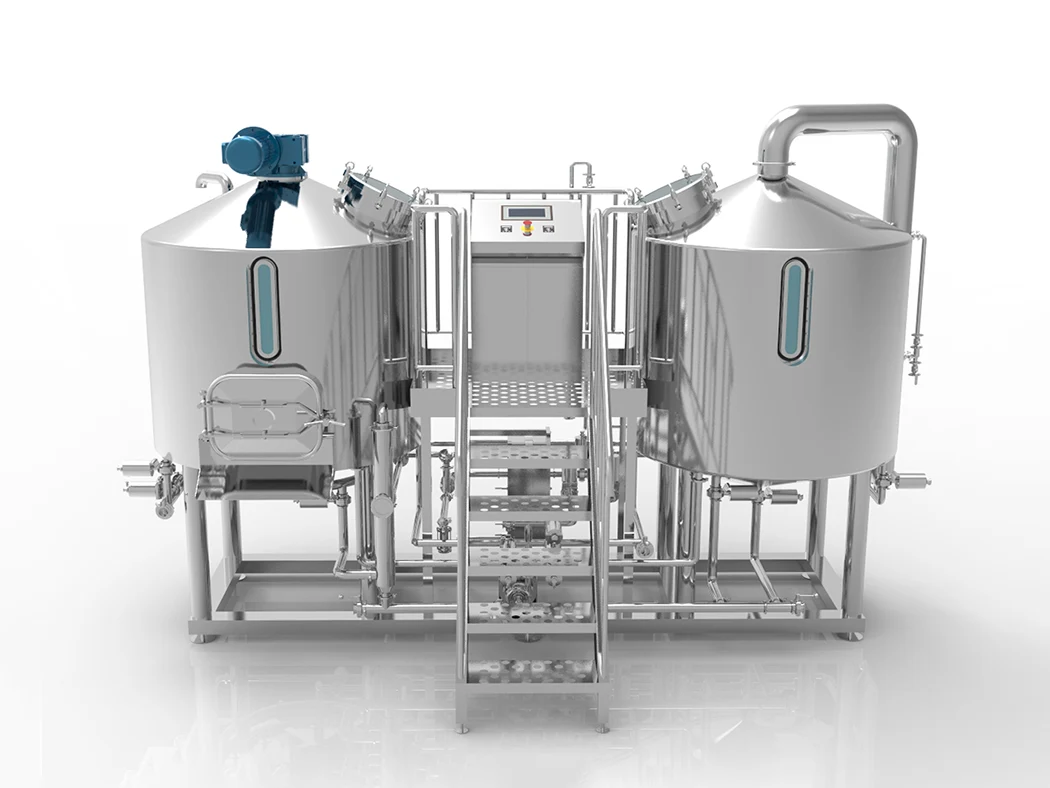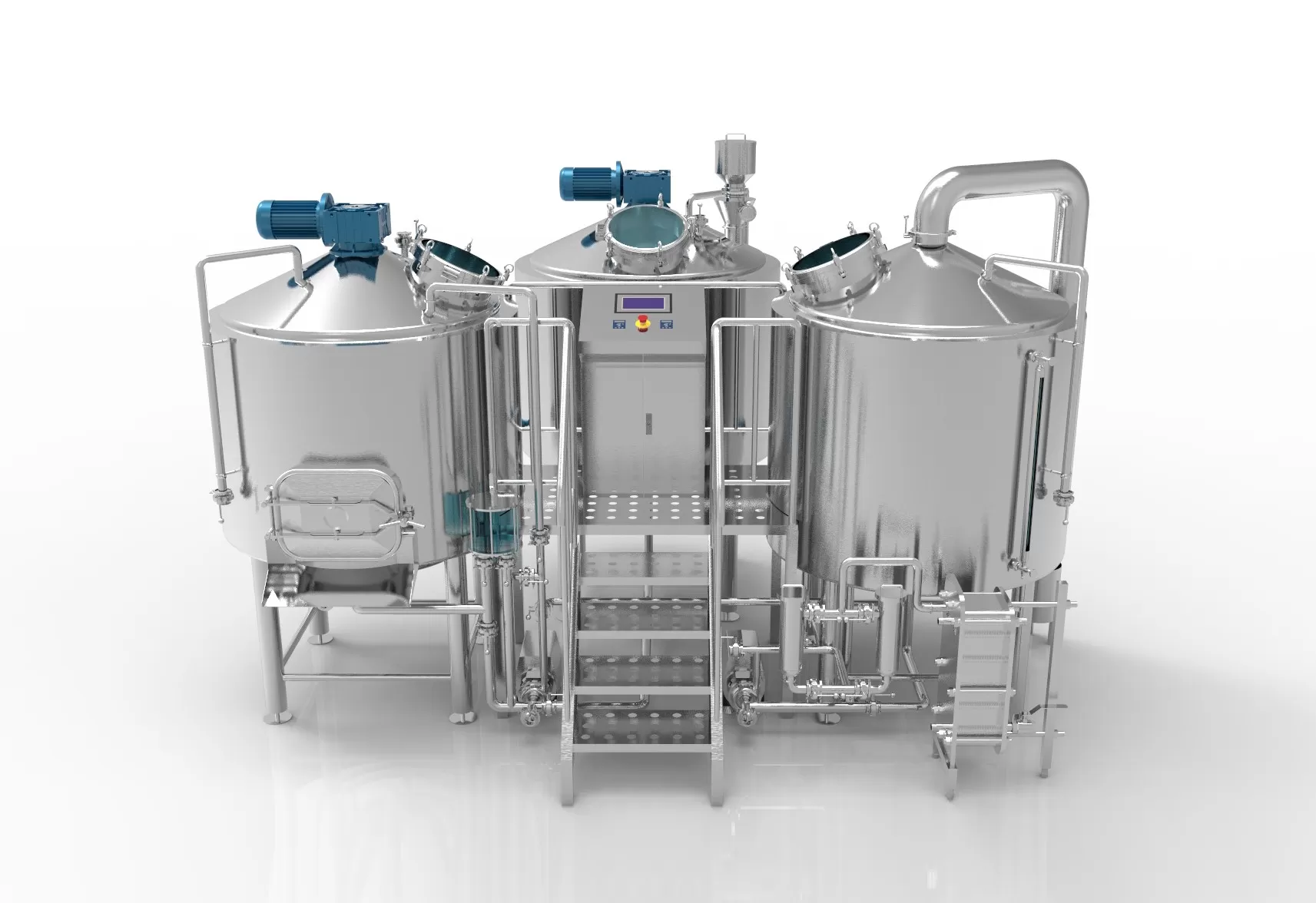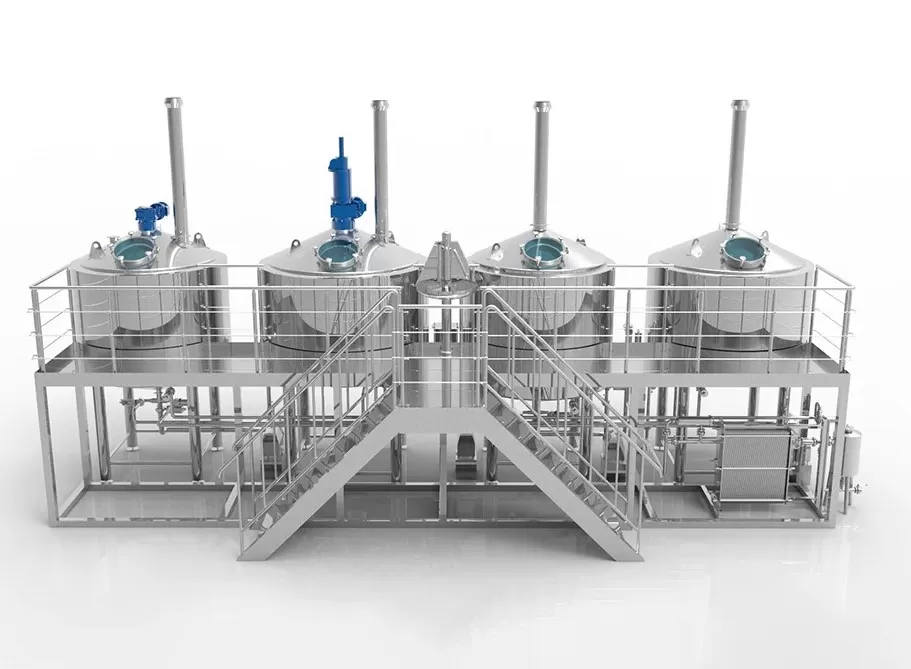Starting or upgrading a brewery feels overwhelming, right? Choosing the wrong 맥주 양조 장비 leads to costly mistakes, poor 맥주 quality, and crippling inefficiency. Don’t let equipment choices stall your dream; this guide simplifies the 양조장 setup process, ensuring you invest wisely for success.
Essential beer brewing equipment forms the heart of any brewery, enabling the transformation of simple ingredients like malt, water, hops, and yeast into diverse beer styles. Key components include the brewhouse (mash tun, lauter tun, kettle, whirlpool), fermentation vessels (fermenters, brite tanks), hot/cold liquor tanks, pumps, chillers, a grain mill, and packaging systems (kegging, canning, or bottling lines). Selecting the right size, configuration, and quality of this equipment is crucial for efficient production and crafting exceptional beer.
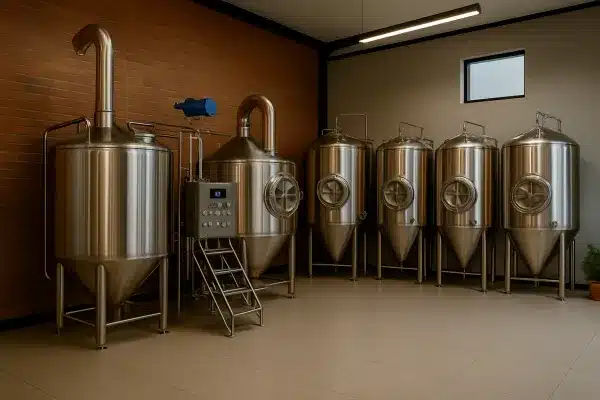
What Core Components Make Up Beer Brewing Equipment?
Embarking on the journey of setting up a 양조장, whether a small startup or a large commercial operation, begins with understanding the fundamental pieces of 장비 및 소모품. Think of it as assembling the engine of your beer making operation. Each component plays a critical role in the 추출 과정, from raw grain handling to the final packaged product ready for your customers. Without the right setup, achieving consistent, high-고급 맥주 becomes a significant challenge.
At its core, a 양조장 needs a system to handle hot processes (the 양조장) and cold processes (발효 and conditioning). This includes:
-
곡물 처리: A 곡물 밀 to crack the malt kernels, exposing the starches for conversion.
-
Brewhouse: The heart of the 양조장, typically comprising:
-
매시 툰: Where crushed grains meet hot water to convert starches into fermentable sugars (mash).
-
라우터 툰: Separates the sweet liquid (wort) from the grain husks. Often combined with the 매시 툰.
-
양조 주전자: Where the wort is boiled, sterilized, and hops are added for bitterness, flavour, and aroma.
-
월풀: Creates a vortex to separate hop debris and proteins (trub) from the clear, hot wort before cooling.
-
-
열교환기: Rapidly cools the hot wort to the optimal temperature for 효모 pitching.
-
발효 용기: 스테인리스 스틸 탱크 (종종 원뿔형 발효기) where 효모 consumes sugars in the wort, producing alcohol and CO2. This is where 맥주 is truly made.
-
Brite Tanks (Conditioning Tanks): Used for clarifying, maturing, and achieving precise 탄산 levels in the 맥주 before packaging.
-
Supporting Systems: Pumps, hoses, valves and fittings, temperature control systems (냉각기), a CIP (Clean-In-Place) system for sanitation, and potentially filtration equipment.
-
포장 장비: Kegging systems (keg couplers, washers, fillers), bottling lines (filler, capper), or canning lines.
As experienced 양조 장비 manufacturers, we’ve seen countless variations, but these core elements form the backbone of nearly every successful brew. The scale, configuration (like the number of 선박 에서 양조장), and level of automation can vary dramatically, but the fundamental process remains the same. Understanding these components is the first step towards designing 장비 설계 specifically for your needs.
How Does the Brewhouse Function in Beer Making?
The 양조장 is where the magic truly begins in the 맥주 양조 process. It’s the “hot side” of the 양조장, responsible for creating the sugary liquid known as wort, which is the precursor to 맥주. Think of it as the kitchen where the fundamental recipe takes shape. The efficiency and design of your 양조장 directly impact wort quality, consistency between batches, energy usage, and overall brew day length.
Typically, the process starts in the 매시 툰. Here, precisely milled malt is mixed with hot water at specific temperatures. This mash process activates enzymes within the malt, converting complex starches into simpler sugars that the 효모 can later consume during 발효. Temperature control is absolutely critical here. After the mash rests, the liquid wort needs to be separated from the spent grains. This happens in the 라우터 툰 (or often a combined mash/lauter tun). Hot water (sparge water) is gently rinsed through the grain bed to extract as much sugar as possible, resulting in the sweet wort.
This wort is then transferred to the 양조 주전자. Here, it undergoes a vigorous boil, typically for 60-90 minutes. Boiling serves several crucial purposes: it sterilizes the wort, drives off unwanted volatile compounds, isomerizes hop acids (extracting bitterness from hop additions), and can cause colour and flavour development. Hops are added at different stages during the boil to impart bitterness, flavour, and aroma. Finally, before cooling, the boiling wort is often sent through a whirlpool vessel or process. This uses centrifugal force to collect hop particles and coagulated proteins (trub) into a neat cone at the center of the 탱크, allowing clearer wort to be drawn off for cooling via the 열교환기. Each step in the 양조장 is vital for crafting the foundation of your 고급 맥주.
Why are Fermentation Vessels Crucial for Your Brewery?
If the 양조장 is the kitchen, then the 발효 용기 are where the raw ingredients transform into the final product. This is the “cold side” where the cooled wort meets 효모, and the actual 발효 occurs. The quality, design, and cleanliness of your 발효기 그리고 브라이트 탱크 are paramount for producing clean, consistent, and high-quality 맥주. You simply cannot underestimate the importance of this stage.
The most common type of 발효기 in modern craft breweries is the cylindroconical 탱크 (often just called a 원뿔형 발효기). These versatile stainless steel vessels are typically jacketed for precise 온도 제어, which is crucial as 효모 activity generates heat. The conical bottom allows for easy collection and removal of yeast and trub after 발효. Primary 발효 usually takes one to two weeks, depending on the 맥주 style and yeast strain. During this time, yeast converts sugars into alcohol and CO2, creating the defining characteristics of the 맥주. Proper 온도 제어 ensures the yeast performs optimally and prevents the production of off-flavours.
After primary 발효, the “green” 맥주 is often transferred to a 브라이트 탱크 (or conditioning 탱크) or conditioned in the same 발효기. . 브라이트 탱크 is a pressure-rated vessel used for clarifying the 맥주 (allowing remaining yeast and particulates to settle), maturing flavours, and achieving the desired level of 탄산. 탄산 can be done naturally by capturing CO2 produced during the end of fermentation (spunding) or by force carbonating with external CO2. From the 브라이트 탱크, the 맥주 is finally ready for packaging into kegs, bottles, or cans. As manufacturers of high-quality 스테인리스 스틸 발효 탱크 및 브라이트 탱크, we emphasize the importance of sanitary design, robust construction (often using 304 스테인레스 스틸), and reliable 온도 제어 in these critical beer tanks.
What Should You Consider When Selecting a Grain Mill?
Often overlooked by newcomers, the 곡물 밀 is a foundational piece of 양조장 장비. While seemingly simple, its performance directly impacts your brewhouse efficiency and the consistency of your mash. Choosing the right mill ensures you get the most sugar extraction from your malt without causing problems down the line. An improper crush can lead to a stuck sparge (where wort flow stops during lautering) or lower-than-expected sugar yield, affecting your final beer’s alcohol content and body.
The primary function of a 곡물 밀 is to crack the outer husk of the malt kernels while crushing the internal starches (endosperm). You want the husks to remain relatively intact, as they form a natural filter bed during the lauter process. However, the endosperm needs to be sufficiently broken up to allow hot water access for starch conversion during the mash. Most brewery mills use adjustable rollers (typically two or four rollers) to achieve this. The gap between the rollers determines the fineness of the crush. Finding the optimal crush setting often requires a bit of experimentation based on your specific 양조장 setup (especially your 라우터 툰 design) and the type of malt being used.
Key considerations when selecting a 곡물 밀 include:
-
Throughput: 수 있습니까? mill process enough grain quickly enough for your batch size and brew schedule? Look at ratings in kg or lbs per hour.
-
Roller Adjustability: Fine control over the roller gap is essential for dialing in the perfect crush for all-grain brewing.
-
Number of Rollers: Four-roller mills generally offer a more consistent crush with better husk preservation compared to two-roller mills, but come at a higher cost.
-
Material: Durable materials like hardened steel for the rollers ensure longevity.
-
Dust Control: Milling creates dust; consider options for dust mitigation or collection.
-
Integration: Will the mill feed directly into a grist case or auger system connected to your 매시 툰?
Investing in a quality 곡물 밀 pays dividends in efficiency and consistency for every brew. It’s a critical first step in the beer making 프로세스.
How Do Pumps, Valves, and Fittings Impact Your Brewing Process?
While the big shiny 탱크 often get the most attention, the network of 펌프, valves및 피팅 forms the circulatory system of your 양조장. These components are responsible for moving liquids – water, mash, wort및 맥주 – between different 선박 safely and efficiently. The quality, type, and layout of this plumbing directly impact sanitation, flow control, process efficiency, and operator safety. Choosing the wrong components can lead to leaks, contamination risks, flow restrictions, and difficult cleaning processes.
펌프 are essential for transferring liquids, especially in larger systems where gravity feeding isn’t practical. Brewery pumps need to be sanitary (easily cleanable), robust enough to handle varying temperatures and viscosities (like thick mash 또는 hot wort), and ideally designed to minimize shearing forces that could damage delicate compounds. Centrifugal pumps are common, often paired with Variable Frequency Drives (VFDs) to allow precise flow control. 밸브, such as butterfly valves or ball valves, control the start, stop, and direction of flow through pipes and hoses. They must be sanitary, easy to operate, and made from durable materials like 304 스테인레스 스틸 to withstand cleaning chemicals and temperature fluctuations. Look for valves that minimize dead space where microbes could hide.
Fittings (like tri-clamp fittings, commonly used in breweries for their sanitary design and ease of assembly/disassembly) connect pipes, hoses, valves, and equipment. Using standardized, high-quality 피팅 ensures leak-proof connections and simplifies maintenance and cleaning. Every connection point, every 밸브, every meter of pipe 또는 hose needs to be considered part of the overall system design. As providers of 양조장 부품, we understand that reliable valves and fittings are crucial for smooth operation and maintaining the integrity of your 맥주 throughout the entire 추출 과정.
What is the Role of CIP Systems in Maintaining Brewery Hygiene?
Cleanliness isn’t just next to godliness in a 양조장; it 는 godliness. Maintaining impeccable hygiene is non-negotiable for producing stable, high-고급 맥주 free from spoilage organisms and off-flavours. This is where a Clean-In-Place (CIP) system becomes indispensable, especially in commercial 양조장. A CIP system allows for the effective cleaning and sanitizing of 탱크, pipes, and other 양조 장비 without requiring disassembly, saving significant time and labour while ensuring thorough results.
A typical CIP system consists of 탱크 for holding cleaning and sanitizing solutions, a 펌프 to circulate these solutions, and associated valves, hoses, and often a 열교환기 to control solution temperature. The process usually involves several cycles:
-
Pre-Rinse: Flushing with water to remove loose soil and debris.
-
가성 세척: Circulating a hot alkaline detergent solution (like caustic soda) to break down organic soils (proteins, hop resins, yeast).
-
중간 헹굼: Flushing with water to remove the caustic solution.
-
Acid Wash (Optional but Recommended): Circulating an acid solution to remove mineral deposits (beerstone) and neutralize any remaining caustic.
-
최종 헹굼: Flushing thoroughly with water.
-
Sanitize: Circulating a sanitizing solution (like peracetic acid – PAA) just before the 장비 is needed for the next brew 또는 맥주 transfer, killing any remaining microorganisms.
Effective CIP relies on the “TACT” principles: Time, Action (flow rate/turbulence), Chemical concentration, and Temperature. Your CIP system needs to be designed to deliver the correct parameters for each piece of 장비 being cleaned. Investing in a well-designed CIP system is investing in 맥주 quality, consistency, and brand reputation. It ensures that every 배치 starts with a clean slate, allowing the desired flavours of your malt, hops, and 효모 to shine through without interference from unwanted microbes. Trying to make beer commercially without a proper CIP process is fighting an uphill battle you are unlikely to win.
Exploring Different Brewhouse Configurations: 2-Vessel vs. 3-Vessel vs. 4-Vessel?
선택 시 양조장 장비, one of the most significant decisions revolves around the configuration of the 양조장. The number of main 선박 (typically referring to the 매시 툰, 라우터 툰, 양조 주전자, and whirlpool) dictates the workflow, potential throughput, flexibility, and initial cost. The most common configurations are 2-Vessel, 3-Vessel, and 4-Vessel systems.
-
2-Vessel Brewhouse: This is the most common setup for smaller microbreweries and brewpubs. It typically combines the 매시 툰 그리고 라우터 툰 into one vessel (Mash/Lauter Tun or MLT) and the 양조 주전자 and whirlpool into a second vessel (Kettle/Whirlpool Tun or KWT).
-
장점: Lower initial cost, smaller footprint. Simple to operate.
-
단점: Less efficient use of time, as you cannot start mashing the next brew until the 주전자 is empty from the previous one. Limits throughput (typically one 배치 per brew day unless very long days are worked). Our 10BBL 2 용기 소규모 양조장 장비 is a popular example.
-
-
3-Vessel Brewhouse: This configuration typically separates the 매시 툰, 라우터 툰및 brew kettle/whirlpool into distinct 선박. Sometimes the whirlpool is also a separate vessel.
-
장점: Increased efficiency and throughput. Allows for starting the mash of the next 배치 while the previous 배치 is boiling in the 주전자. Offers more flexibility in mashing techniques.
-
단점: Higher cost and larger footprint than a 2-vessel system. More complex plumbing and control. Ideal for growing breweries, like our 1500L 3 용기 양조장 장비.
-
-
4-Vessel Brewhouse: This setup features dedicated 선박 for each primary hot-side process: 매시 툰, 라우터 툰, 양조 주전자, and Whirlpool 탱크.
-
장점: Maximum efficiency and throughput, allowing for multiple brews per day (back-to-back 양조). Offers the greatest flexibility and control over each step. Standard for larger production 양조장.
-
단점: Highest initial cost, largest footprint, greatest complexity in operation and automation. See our 20HL 4 용기 상업용 양조장 장비 for an example of a robust commercial system.
-
Choosing the right configuration depends heavily on your production goals, budget, available space, and desired operational workflow. As manufacturers, we design and build all configurations, tailoring the 양조장 to meet the specific needs of each 양조장.
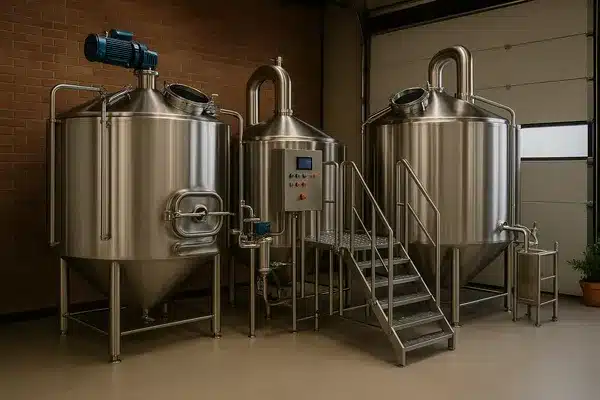
Kegs, Bottles, or Cans: Choosing Your Beer Packaging Filler Equipment?
Once your 맥주 is perfectly fermented, conditioned, and carbonated in a 브라이트 탱크, the final step before it reaches the consumer is packaging. The choice between kegs, bottles, and cans significantly impacts your distribution strategy, market reach, branding, and the type of packaging equipment you’ll need. Each format has its pros and cons, and many 양조장 utilize a combination.
-
케그: The traditional format for draft 맥주 served in pubs, bars, and restaurants, as well as for direct sales from the 양조장 taproom. 케깅 generally requires the lowest initial investment in packaging equipment (keg washers and fillers).
-
장점: Relatively low cost per volume, excellent protection against light and oxygen, reusable (kegs can last for decades), preferred format for on-premise consumption. Requires keg couplers at the point of dispense.
-
단점: Limited reach (primarily draft accounts), requires a cold chain for distribution and storage, consumers need specialized equipment (kegerator) for home brew enjoyment.
-
-
Bottles: A classic packaging choice offering good shelf stability and a premium perception for certain 맥주 styles. Bottling lines range from simple manual fillers and 캡핑 tools to fully automated systems.
-
장점: Wide consumer acceptance, good shelf life (especially dark glass), allows for bottle conditioning, perceived quality image. Requires bottle caps.
-
단점: Heavier and bulkier than cans (higher shipping costs), susceptible to light damage (especially clear or green glass), risk of breakage, higher oxygen pickup potential during filling compared to modern canning. Slower filling speeds compared to canning on automated lines.
-
-
Cans: Increasingly popular in the 수제 맥주 world due to their portability, sustainability, and superior protection against light and oxygen. Canning lines are typically more complex and expensive than basic kegging or bottling setups.
-
장점: Complete protection from light, near-zero oxygen pickup with good filler technology, lighter weight (lower shipping costs), highly recyclable, stackable, portable, appeals to modern consumers.
-
단점: Higher initial investment in canning line, potential for negative consumer perception (though this is fading fast), requires careful seam inspection to ensure integrity.
-
Your choice will depend on your target market, production volume, budget, and brand strategy. Investing in reliable 포장 장비 is crucial to ensure your carefully crafted 맥주 reaches the drinker in the best possible condition, whether it’s perfectly carbonated in a keg, securely sealed in a bottle, or protected from the elements in a can.
Beyond the Basics: Essential Brewery Ancillary Equipment?
While the 양조장 그리고 발효 탱크 are the stars, a supporting cast of ancillary 장비 is essential for a functioning and efficient 양조장. These systems might not be involved directly in mashing or fermenting, but they provide critical utilities like heating, cooling, cleaning, and analysis that enable the core processes to run smoothly and effectively. Neglecting these can create bottlenecks, compromise quality, and increase operating costs.
Key ancillary systems include:
-
Hot Liquor Tank (HLT): Stores and heats the water used for mashing and sparging. Having a dedicated HLT allows for faster brew days as large volumes of water can be pre-heated.
-
Cold Liquor Tank (CLT): Stores cold water, often chilled water, used primarily for rapidly cooling the wort through the 열교환기. Crucial for consistent 발효 temperatures and efficient 냉각기 operation.
-
Chiller / Glycol System: Provides the cooling capacity needed for crashing wort temperatures post-boil (via the 열교환기) and maintaining precise 발효 온도 제어 in jacketed 발효기 그리고 브라이트 탱크. Usually involves circulating a chilled food-grade propylene glycol/water mixture.
-
Boiler or Steam Generator: Provides steam for heating the 양조 주전자 and HLT in larger systems (steam heating is generally more efficient and responsive than direct fire or electric brewing elements for large volumes).
-
Pumps, Hoses, and Piping: As discussed earlier, essential for moving liquids. Includes sanitary hoses, hard pipe installations, and reliable transfer 펌프. Ensure you have the right hose types for different temperature and pressure requirements.
-
Control Panel / Automation: From basic temperature controllers to fully 자동화된 양조 시스템, controls manage temperatures, 펌프 operations, valve actuation, and process timing, ensuring consistency and repeatability.
-
Lab Equipment: Essential for quality control. Includes tools like a hydrometer (or refractometer) for measuring sugar content (wort gravity), pH meter, thermometer, microscope (for yeast health checks), and potentially dissolved oxygen meters. Helps the brewer make informed decisions and track 맥주 consistency.
These supporting systems work together to create a cohesive and efficient 맥주 양조 operation. When planning your equipment for your brewery, remember to budget and allocate space for these vital ancillary components. They are fundamental to producing 고급 맥주 consistently and efficiently.
How Can Micet Group Help You Choose the Right Brewing Equipment?
Navigating the complex world of 양조장 장비 can be daunting, especially with so many options and configurations available. That’s where we, Micet Group, come in. As experienced manufacturers of high-quality, customizable 양조 장비, we partner with breweries of all sizes – from startup home brewers scaling up, to brewpubs, 수제 맥주 양조장, and large 상업용 양조장 operations – to design and build systems tailored to their specific needs and goals. We understand the challenges you face because 양조 is in our DNA.
Our approach is built on collaboration and expertise. We don’t just sell 탱크; we provide complete solutions. This starts with understanding your vision: What kind of 맥주 do you want to brew? What’s your target production volume? What’s your budget and available space? Based on this, our engineers can help you configure the ideal system, whether it’s a compact 1000L Small Batch Brewing System or a multi-vessel 상업용 양조장 setup. We specialize in high-grade 스테인리스 스틸 fabrication (304 or higher), ensuring durability, longevity, and ease of sanitation for all our 장비 설계 for brewing.
We offer a comprehensive range of 장비 및 소모품, including various 양조장 configurations, 발효 용기 (원뿔형 발효기, 브라이트 탱크), 효모 propagation 탱크, CIP systems, keg washers/fillers, and ancillary components like 펌프, 냉각기및 control panels. Our commitment extends beyond manufacturing; we provide installation support, training, and ongoing technical assistance to ensure your 양조장 operates smoothly and efficiently. We aim to be more than just a supplier; we strive to be a trusted partner in your 양조 success story. Let us help you turn your 맥주 양조 dreams into reality with reliable, efficient, and customizable 양조장 장비.
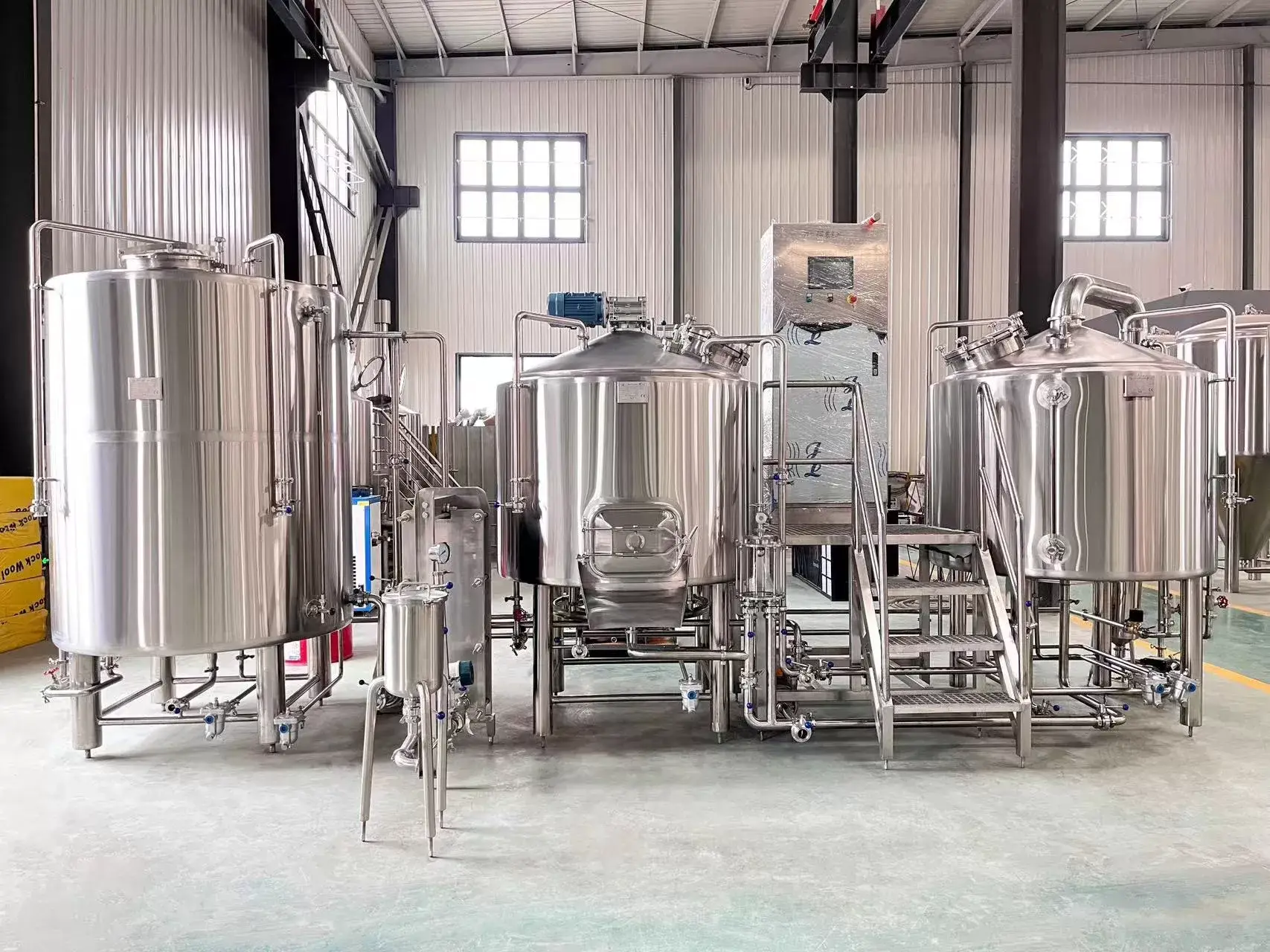
자주 묻는 질문
What is the difference between a mash tun and a lauter tun?
A 매시 툰 is the vessel where crushed malt and hot water are mixed to convert starches into fermentable sugars (the mash). A 라우터 툰 is designed specifically to separate the sweet liquid wort from the solid grain husks after mashing. In many smaller 양조장 (like 2-vessel systems), these two functions are combined into a single vessel called a Mash/Lauter Tun (MLT). Larger, higher-efficiency systems often use separate 선박 for optimized performance of each step.
How long does beer need to stay in a fermenter?
The time 맥주 spends in a 발효기 varies significantly depending on the 맥주 style, yeast strain, and 발효 temperature. Primary 발효, where most of the alcohol is produced, typically takes 1-2 weeks for ales and potentially longer (3-6 weeks or more) for lagers fermented at cooler temperatures. After primary 발효, the 맥주 might be conditioned or matured for additional days, weeks, or even months, either in the same 발효기 or transferred to a separate conditioning 탱크 또는 브라이트 탱크.
What does CIP stand for and why is it important in a brewery?
CIP stands for Clean-In-Place. It’s a method for cleaning the interior surfaces of pipes, 선박, 탱크및 피팅 without disassembling the equipment. A CIP system circulates cleaning and sanitizing solutions throughout the 양조장 장비. It’s critically important because 맥주 is susceptible to spoilage by bacteria and wild yeast. Regular and effective CIP ensures that equipment is hygienically clean, preventing contamination and ensuring the production of consistent, high-고급 맥주. It also saves significant time and labor compared to manual cleaning.
What basic equipment do I need to start homebrewing beer?
To start 홈 브루잉 simple extract-based beer at home, you typically need a basic brewing kit. This usually includes a large pot (주전자) for boiling the wort, a 발효기 (often a food-grade bucket or carboy with an airlock), tubing for transferring (siphoning), a sanitizer, cleaner, and bottling equipment (bottles, bottle caps, a capper) or a small kegging setup. You’ll also need measuring tools like a thermometer and potentially a hydrometer to measure sugar levels. Many beginners start with all-in-one electric 브루잉 시스템 that combine the 주전자 그리고 mash functions for easier all-grain brewing.
Can I use the same tanks for brewing beer and kombucha?
While both involve 발효, it’s generally strongly recommended not to use the same 발효 용기 에 대한 맥주 and kombucha interchangeably without extremely rigorous cleaning and sanitation protocols. Kombucha fermentation relies on a symbiotic culture of bacteria and yeast (SCOBY), which includes microorganisms like Acetobacter that can cause souring and undesirable flavours in 맥주. Even trace amounts surviving cleaning could potentially infect subsequent 맥주 batches. Dedicated Kombucha Fermentation Tanks are the safest approach to prevent cross-contamination.
How is beer carbonated in a commercial brewery?
상업용 양조장 typically carbonate 그들의 맥주 in 브라이트 탱크 (conditioning 탱크) after 발효 and clarification. This is usually done through “force carbonation,” where CO2 gas is bubbled through a porous “stone” submerged in the 맥주 within the pressurized 탱크 until the desired dissolved CO2 level is reached. Alternatively, some 양조장 use “spunding,” where the 발효기 is sealed towards the end of 발효 to naturally trap the CO2 produced by the 효모. Precise temperature and pressure control are essential for achieving consistent 탄산.
Key Takeaways for Selecting Beer Brewing Equipment:
-
Core Components: Understand the function of each key piece: 곡물 밀, 양조장 (매시 툰, 라우터 툰, 주전자, whirlpool), 열교환기, 발효기, 브라이트 탱크.
-
Brewhouse Configuration: Choose the right number of 선박 (2, 3, or 4) based on your production goals, space, budget, and desired workflow efficiency.
-
Fermentation is Key: Invest in quality stainless steel fermentation vessels with reliable 온도 제어 and sanitary design for consistent, high-고급 맥주.
-
Don’t Forget Ancillaries: Systems like 냉각기, boilers, 펌프, valves, 피팅및 CIP are crucial for efficient and hygienic operation.
-
Packaging Matters: Select kegging, bottling, or canning 장비 based on your target market, distribution strategy, and budget.
-
Cleanliness is Crucial: Implement rigorous cleaning and sanitation protocols, ideally utilizing an effective CIP 시스템.
-
Customization & Support: Partner with an experienced manufacturer like Micet Group who can provide customizable solutions and ongoing technical support for your 양조장 장비.

